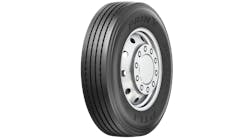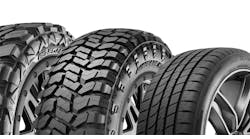Given all of the hazards associated with roadside tire service, it still only represents about half the risk for commercial tire dealers. That’s right. You read that correctly. Serving tires on the side of a highway only represents half the risk associated with operating a fleet of road service trucks (see part one of this article in our February issue).
Perhaps the greatest risk from a statistical perspective is the actual driving of the vehicle. Emergency road service on the side of a highway is not the most common type of daily operation for a service truck. The majority of the time it is delivering and servicing tires at fleet locations where passing traffic is not an issue. Therefore, it can be said that the time spent driving on the highways, roads, streets, side streets and parking lots creates more risk for the company than the actual work that is performed.
The majority of commercial tire dealers in business today have systems in place to reduce the risk when servicing tires out of service trucks. Restraining devices, inflation equipment, jack stands and other vital safety equipment are in place and used on a regular basis. Those risks are being managed. On the other hand, how much attention is being given to driver safety? Does the company have systems in place to manage the risk of operating a fleet of company vehicles over a potentially large geographical area? It’s an area of operations that is easy to overlook, but the consequences of a seemingly minor traffic accident are worsening by the day.
You’ve seen the commercials. A well-dressed person in a business suit wants to help you recover damages from an accident. We’ve got one in the Baltimore area that specializes in commercial truck cases. He stands on top of a trailer and guarantees that he will get you a pile of money if you are hit by a commercial truck. Commercial vehicles are targets for these types of legal assassins and when your name is on the side of the truck, you are a fish in a barrel. The legal term is Vicarious Liability, and according to Federated Insurance, it means “an employer can be liable for the acts or omissions of its employees, provided it can be shown that they took place in the course of their employment.”
Technician A was out late on an overnight road service call and only gets a few hours of sleep. The following afternoon, he fails to stop at a stop sign and strikes a passing vehicle. Work records show that the technician was probably fatigued at the time of the accident.
Technician B and Salesman A are well-rested and simply look down at their cell phones for a split second and then rear-end the car in front of them. Law enforcement officials find the phones on the floors of the cabs and based on the time of the accident and traffic camera footage, they conclude that the drivers were texting while driving. Which company has more liability?
The answer is they are both in a difficult position. While hours-of-service regulations do not apply to the average road service technician, they can be used to demonstrate best practices in the event of an accident. Technicians who perform night calls should be given ample time to rest before beginning another shift. Plaintiff attorneys like the guy on top of the truck will subpoena the work records of every road service technician such as time sheets, payroll and work orders. If they can show a systemic problem of employees who drive company vehicles working without adequate time off the clock, it raises the stakes for any associated liability.
In the case of Technician B or Salesman A, did the company have a policy regarding texting while driving? Even worse, was he texting his service manager or another employee? If traffic cameras show the company-owned truck being driven on the road and the timestamps on texts or phone calls overlap the timestamps on the camera footage, it will be a foregone conclusion that the drivers were texting or talking on their phones while driving.
Federated Insurance has responded to the risks of Vicarious Liability by launching their Drive S.A.F.E. program. This program is designed to help companies avoid preventable losses by raising awareness of the most common factors that lead to vehicle crashes. Speed, Attention, Fatigue and Emotion all play critical roles in the safe operation of company vehicles, so Federated is taking steps to help the industry by offering some risk management guidelines to minimize the amount of Vicarious Liability.
According to the Insurance Institute for Highway Safety (IIHS), about 30% of all motor vehicle crash deaths can be linked to speeding. Of that 30%, almost half of those deaths occurred when speeds were over 55 mph.
Time is money for a lot fleets, which means technicians may feel pressured to shave a few minutes in response time by exceeding the posted speed limits. Employers should discourage this practice and can take steps to manage the driving habits of employees. GPS is becoming more common for a variety of reasons, but the ability to monitor the speed and location of every company vehicle will become part of a strong defense in the event of an accident. Telling an employee not to exceed the posted speed limit is one thing. Telling that employee that their speed will be monitored is another.Federated estimates that 10% of all fatal crashes and 18% of all injury crashes are caused by distractions. When employees are operating company vehicles, they should be paying attention to the road and the traffic around them. Employers should have policies regarding cell phone use while driving (depending on the state) and prohibit texting while driving under all circumstances. At 65 mph, a vehicle travels a little over 95 feet per second. That’s about the length of a football field in just 3 seconds. Employees who drive company vehicles must be aware of distracted driving while policies are put in place to minimize those distractions.
In my opinion, the key words in the definition of Vicarious Liability are “in the course of their employment.” It’s more difficult for an employer to be held accountable for the actions of a fatigued employee when the employer has no knowledge of the reason for the fatigue.
On the other hand, if an employee clocks out at 5 p.m., clocks back in for an overnight road call the following day at 2 a.m., clocks out at 4 a.m. and then clocks back in at 8 a.m., the case for Vicarious Liability would likely be much stronger because the fatigue was the direct result of their employment. How do you think it will sound to the jury when the employer knew that the employee had limited sleep yet allowed them to operate a company vehicle?
The Center of Disease Control (CDC) estimates that as many as 6,000 fatal crashes are caused by drowsy drivers each year. The CDC recommends that if a driver notices the signs of drowsy driving, like yawning or blinking frequently, drifting from their lane or hitting the rumble strips on the side of the road, at a minimum they should pull over to a safe place and take a 15 to 20 minute nap. Employees who drive company-owned vehicles should be educated on the causes and effects of drowsy driving. Their employers should have policies/guidelines in place and enough trust in their employees to allow them sufficient rest when necessary.
Road rage and aggressive driving
There is a clear distinction between road rage and aggressive driving. Aggressive driving is defined by the National Highway Traffic Safety Administration (NHTSA) as an event where the driver, “commits moving traffic offenses so as to endanger other persons or property.” NHTSA defines road rage as “an assault with a motor vehicle or other dangerous weapon by the operator or passenger of one motor vehicle on the operator or passengers of another motor vehicle.” One usually results in a series of traffic tickets while the other often results in a criminal charge. Neither look good to a jury when a company-owned vehicle is involved.
Service truck drivers are probably the least likely to commit acts of aggressive driving or road rage because the name of the company is plastered all over the truck. A big white truck with ABC Tire Co. on the side is going to be easy to identify if the driver acts aggressively.
I can remember getting called into my dad’s office once because someone saw me speed through an intersection to beat a red light. It was back in the day before mobile phones so someone took the time to either write down the name of our business or remembered it and then followed up with a phone call. It didn’t happen again.
Emotions affect everything that we do and if a salesman is having a bad day and purposefully tailgates the car in front, honks the horn, and uses obscene gestures to express their anger at another driver, they may think they are getting away with it because the vehicle is unmarked.
However, if that same driver ends up causing an accident and the combination of traffic cameras and witness accounts support the charge of aggressive driving or road rage, the employer will be held accountable. Some estimates suggest that 66% of all traffic fatalities are caused by aggressive driving and about half of the drivers who receive aggressive behavior respond with the same behavior. Employees must be aware of the consequences associated with aggressive driving while receiving training on how to prevent, avoid and de-escalate a situation when confronted.My golden rule of training has always been “to change behavior in a positive manner.” Whether it’s emergency road service or driving a company vehicle, the need for employee training will always be there because certain concepts require constant reinforcement.
While I will agree that education plays a vital role in liability protection, the primary purpose should be focused on getting people to do things better and safer. That’s at the heart of risk management. The risks associated with operating service trucks and other company vehicles will always be present. They cannot be eliminated, but they can be controlled and managed.
Employees must recognize that safety is a personal responsibility so following procedures when performing road service is the best way to protect themselves. They must also recognize that when they are behind the wheel of a company-owned vehicle on company time, they have an obligation to their employer to drive responsibly.
Lives and livelihoods are at stake every time an employee drives a company-owned vehicle. If the risks are not managed, lawyers like the guy on television have a much easier target. ?
Kevin Rohlwing is the Tire Industry Association’s senior vice president of training.
Read Part One of this article here.



